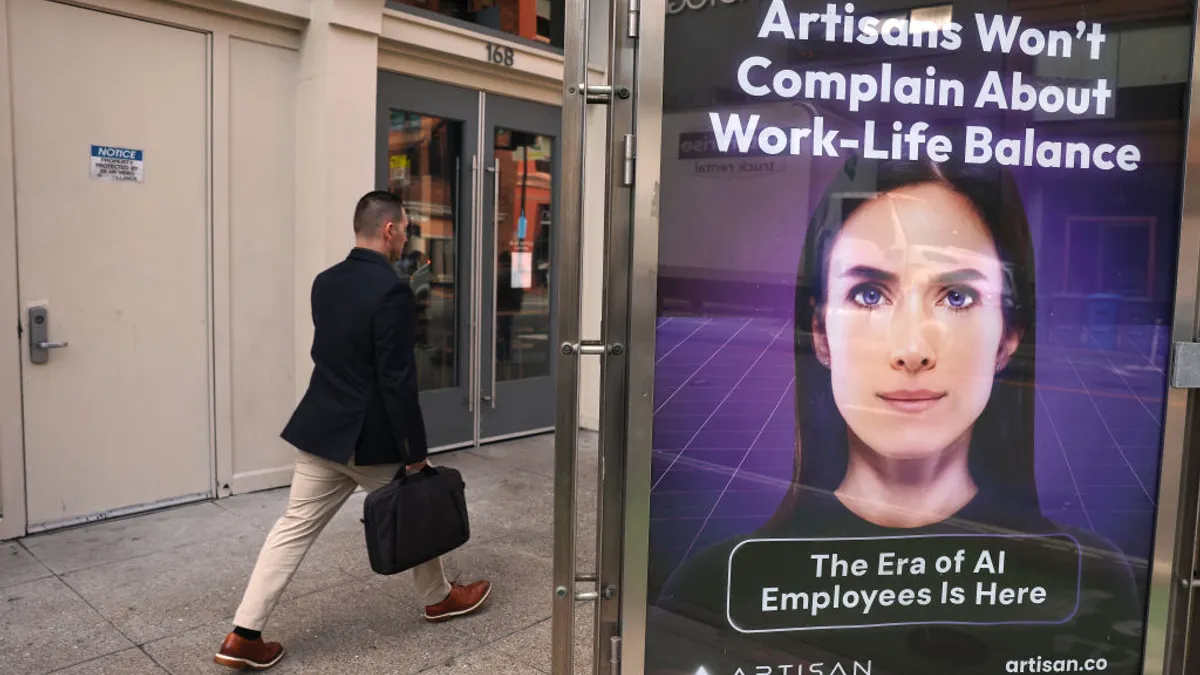You aren’t like the other companies. You’re the cool company (if a little seasoned compared to the Silicon Valley set). But how do you get potential employees — and maybe some current ones — to believe you?
Say what you will about millennials, but their cutting taste, unforgiving sense of what’s hot and what’s not and unwillingness to compromise their values has employers bending over backwards to recruit them successfully. Yet like all who try to trendset, employers that push a brand run a dangerous risk of coming off as not only wholly uncool, but deeply inauthentic and disinterested in their own purported values.
Like any marketing specialist would say, the message is more than just words. Employer brands need to be backed up with action — constant communication and decisions based on values, not just image. In essence, employers need to walk the walk, not just talk the fancy talk.
HR Dive spoke with Bryan Chaney, the talent branding and attraction strategist at Indeed, to discern what it takes to keep a company’s brand on point. The below conversation has been lightly edited for style and length.
HR Dive: One of the big stories in HR is the battle for skilled talent. How can older companies differentiate from these “young-feeling” startups without feeling weird or inauthentic?
Bryan Chaney: So I know several companies that are trying to do that. They see that the younger talent is looking for the companies that are doing the ‘next thing’. They have different benefits, flexible work schedules. With more traditional or established companies I think a lot of times it’s about clarifying what you are going to get.
You have preconceived notions about big name companies and they have to battle that preconceived notion that they are an old and stodgy environment. Some of that is going to be legitimate, and some of it is going to be perceived based upon the age of the company.
You have to effect real change before you can talk about this more advanced, progressive culture.

Bryan Chaney
Talent Branding and Attraction Strategist, Indeed
One of the most important things a company can do is actually effect change. I look at the surface level stuff — social media, reviews, all those things that you can quickly access — as the icing on the cake. I look at the actual culture, the support an employee experiences working at the company as the cake itself. It’s got to have layers.
You have to have the understanding that you have to effect real change before you can talk about this more advanced, progressive culture.
HR Dive: How can you communicate that you are making this real change internally and externally?
Chaney: Communicating internally is big. I’m sure there are other people who are more extensively seasoned when it comes to internal communications. My goal is getting employees engaged to tell stories externally. I get to be the storyteller and help other people be the storyteller for their experiences inside Indeed.
From a culture standpoint, it’s about how things are communicated, what’s coming up, what’s happening, how to process the information, how are employees supported … and how does the company ask for feedback around all those things we are so busy delivering that we sometimes forget to ask? Are we doing the right thing?
External feedback happens in many forms. We tend to pay attention to the feedback that is super positive or super negative. We find that a lot of people who provide that feedback swing to one end of that emotional spectrum or the other. The stories in the middle are the ones the people are usually telling their manager or coworkers. They are on their way to either end of that spectrum, either on the way to bad or good.
So a lot of times it is both the internal and external stories that matter.
HR Dive: What about the impact of employee review sites — an external source of branding that employers have supposedly little control over. How are employers dealing with that?
Chaney: A lot of companies are listening. Not all of them are responding. So that tells employees and former employees that you are actually listening and care about that feedback. We review that content across a multitude of networks.
Review sites like Indeed, other social media channels, there are ones popping up all the time. There are so many different ones that it can be hard to keep track, but we are listening. We’re paying attention — and even more important, we are responding and letting both employees and former employees know they are being heard.
We have a response map for when we get a piece of feedback. Whether it is through a review site or a social media channel or an email. It’s understanding not just that we have to ask for it, but the response — it is critically important.
HR Dive: What about the relationship between branding/culture? When things go wrong, how can an employer fix that in the eyes of potential and current employees?
Chaney: I would say figure out if it is an internal or external facing issue first. What I mean by that is if it deals with customers, it is an external-facing issue. If it’s employees, then it is an internal-facing issue. You can make public statements either way.
A company in that situation could make a statement to say, “We are addressing this problem, it’s valid and we are taking it seriously and taking internal measures.”
But some of that stuff does need to stay private for many reasons, particularly in HR. Beyond that, there is the instruction and empowerment you have to give for people who are on and run those communication channels. One of the things I think is super important is response time for service level agreements when it comes to communication channels.
We actually have a 24 business hour response time for our channels and of course we recruit for Indeed so all of ours are people who are potential hires for Indeed. A lot of people are asking questions that are more relevant to our product, like job search, but some of them are really asking questions like ‘what’s my status’ or ‘having an issue applying’ or about a specific kind of job. We respond to those people within the first 24-business hours — a first response, not saying we are going to solve their problem (unless we can really quickly).
On social media, every minute is an hour, and every hour is a day. Understand that the time expectations are so much more compressed.

Bryan Chaney
Talent Branding and Attraction Strategist, Indeed
But we actually have a response map that says “Okay, is it positive? Is it negative? Is there an actionable next step? Or is there not?” That’s how we guide our responses.
Particularly in a crisis, one of the most important things you can do is remove the approval processes or the time between when someone comments or posts or tags your handle or posts on your Facebook page.
What you can do is you can remove the normal processes you have to go through and have the person who is directly connected to the issue work with the channel owner or community director so there’s a direct line of communication there. That way, when you want to post, you can say immediately, ‘Here is how we are going to respond. On social media, every minute is an hour, and every hour is a day. Understand that the time expectations are so much more compressed.
HR Dive: It’s interesting because I think a lot of companies would have the opposite response, but because social media moves so quickly, you have to move quickly, too.
Chaney: You do. If this is someone, for example, a head of PR or a lead executive, they are going to be speaking on behalf of the company anyway. So, it’s better to remove those extra layers which just add time and let them speak directly and work with the person who is guiding the conversation.
HR Dive: One thing we are tying together is the human side of recruiting with emerging technologies. How can employers keep recruiting authentic to them?
Chaney: I think a lot of it has to do with communication and letting people know what to expect. When you say “the human side of hiring,” I think of an employer or recruiter and an applicant or potential candidate.
A lot of times we see a bandwagon of “oh, our candidate is the consumer.” Well, sometimes that is the case and sometimes it is not, and understanding that if there’s an expectation of a recruiting process, and if you tell someone how long a recruiting step is going to take, it’s understanding you are building in that expectation. Not communicating anything is usually communicating the negative.
So it is understanding, you can set expectations from the beginning of your process and just own it and explain the why behind it. Not necessarily authenticity, but to borrow another buzzword, it is transparency — letting people know what to expect and so they don’t have to guess. In the end, they’ll end up happier because of it.
HR Dive: Transparency is a word that requires a little more work to adhere to it than authenticity does, I think.
Chaney: Authenticity means something different to everybody.
HR Dive: And transparency means a similar thing to most people. Any other trends you’ve noticed?
Chaney: The demand has changed within the last five years. People are finding all the information about you and your company and the roles and how you take care of your employees online. That is really a dynamic shift. It is kind of similar to the real estate world in the past 10 years.
People relied on recruiters a long time ago ... you are going to tell me this story, you are going to tell me what I should expect and what I should ask for. You are going to be my translator into this world. With the advent of sites like Zillow and other real estate sites, people now have a lot of information at their fingertips and are coming to conclusions on their own. And I think that’s very similar to employer brand.
There is so much applicants can find online and also in their peer groups that they can come to a rational decision almost before they talk to a recruiter or they decide to apply.
It’s also educating not just the people who are researching but also the real estate agents and the recruiters. Educating them on how to deal with that shift and that expectation. And I think a lot of times what employer branding is doing is bringing that education inside the company.




















